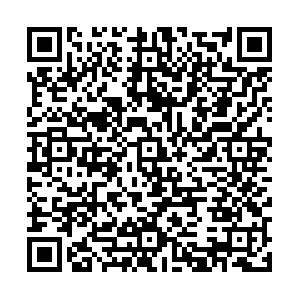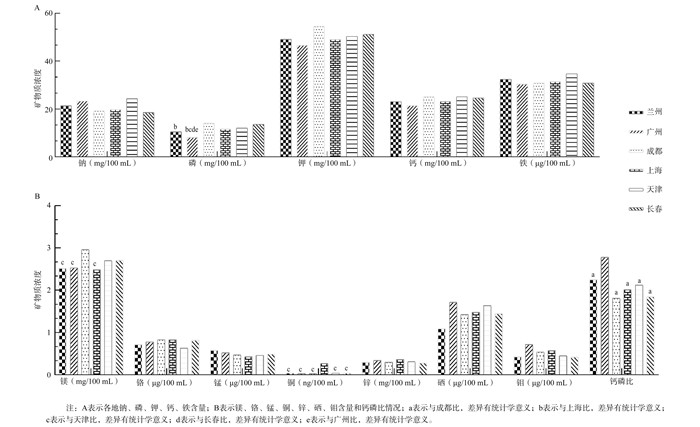The investigation of minerals in human breast milk across lactation stages in six representative areas of China
-
摘要:
目的 调查中国不同泌乳期母乳矿物质含量水平,为婴儿配方(简称婴配)食品研发提供科学依据。 方法 在成都市、上海市、天津市、广州市、长春市、兰州市等六地区招募处于不同泌乳期的健康产妇690例,收集产妇产后0~5 d、10~14 d、40~45 d、200~240 d和300~400 d母乳,每个城市每个泌乳期收集23例母乳,将其混成1份混乳,共获30份混乳。采用电感耦合等离子体质谱法测定母乳12种矿物质(钾、钙、钠、镁、磷、铁、铜、锌、硒、锰、钼和铬)含量。 结果 母乳锌含量下降趋势最明显,整个泌乳期下降近90%(均有P<0.05);钾、钠、锌、铁、铜和硒的浓度受泌乳时间影响大,随泌乳时间延长呈下降趋势(均有P<0.05),200 d后趋于稳定;钙磷浓度的下降趋势较平缓;而镁含量在整个泌乳期变化不大。除钙、磷、铜、镁外,其余矿物质含量在地区间差异无统计学意义(均有P>0.05)。 结论 不同泌乳期、不同地区间母乳矿物质含量存在差异。婴配食品应考虑中国母乳矿物质含量的代表性水平,并针对不同泌乳期婴幼儿的营养需求进行研发,同时提高矿物质吸收利用率,使其更接近母乳,在满足婴幼儿生长发育需求的基础上,不增加其肾脏负担。 Abstract:Objective The study aimed to investigate the representative mineral levels in breast milk at different lactation stages in China and to provide reference and guidance for future infant formula development. Methods A total of 690 healthy parturients at different lactation stages were recruited in Chengdu, Shanghai, Tianjin, Guangzhou, Changchun, and Lanzhou. Milk was collected from parturients at 0-5 d, 10-14 d, 40-45 d, 200-240 d, and 300-400 d after delivery. Determination of 12 minerals (K, Ca, Na, Mg, P, Fe, Cu, Zn, Se, Mn, Mo and Cr) in breast milk was conducted by inductively coupled plasma-mass spectrometry (ICP-MS). Results Across the 5 lactation periods, Zn dropped dramatically (about 90%) (all P < 0.05). Minerals including K, Na, Zn, Fe, Cu, and Se were significantly affected by lactation time and tended to decrease with the prolonging of lactation time (all P < 0.05), while being stable after 200 days. Ca and P were stable at the early stage and then decreased slightly at the middle-late lactation stage. The content of Mg stayed stable over the lactation period. Except for Ca, P, Cu, and Mg, other minerals showed no significant regional difference (all P > 0.05). Conclusions There were differences in the mineral content of breast milk at different lactation stages and different regions. Infant formula should consider the representative levels of mineral content in Chinese breast milk, and be developed according to the nutritional needs of infants at different lactation stages. Meanwhile, the mineral absorption and utilization ratio should be improved to make it more similar to breast milk, so as to meet the growth and development needs of infants without increasing the burden on their kidneys. -
Key words:
- Chinese breast milk /
- Mineral content /
- Different lactation periods /
- Different regions
-
表 1 产妇的人口学特征[n(%)]
Table 1. Demographic characteristics of lactating mothers [n(%)]
基本情况 泌乳期(d) F/χ2值 P值 0~5 10~14 40~45 200~240 300~400 产妇年龄(x±s, 岁) 29.40±3.72 29.63±3.40 29.53±3.49 29.72±3.70 29.69±3.41 0.182 0.948 产前BMI(x±s, kg/m2) 27.30±3.44 27.19±3.49 27.19±2.83 26.75±3.04 26.33±3.18 1.782 0.131 初产妇 86(63.24) 83(62.41) 92(67.15) 88(63.77) 100(74.63) 8.220 0.412 阴道分娩 76(55.88) 77(57.89) 80(58.39) 88(63.77) 84(62.69) 2.548 0.636 文化程度a 7.414 0.829 高中及以下 29(21.32) 23(17.29) 24(17.52) 25(18.12) 29(21.64) 大学/大专 88(64.71) 84(63.16) 93(67.88) 93(67.39) 86(64.18) 硕士及以上 19(13.97) 26(19.55) 20(14.60) 20(14.49) 19(14.18) 注: a表示数据有缺失。 表 2 不同泌乳期母乳矿物质含量(x±s)
Table 2. Detailed mineral levels in breast milk at different lactation stages (x±s)
矿物质浓度 泌乳期(d) F值 P值 0~5 10~14 40~45 200~240 300~400 钾(mg/100 mL) 65.06±5.56 abcd 57.24±2.79 bcd 48.06±3.64 cd 40.41±2.20 40.09±1.88 58.817 <0.001 钙(mg/100 mL) 24.59±2.11 cd 25.93±1.57 cd 25.74±2.57 cd 22.13±1.50 20.64±1.26 9.391 <0.001 钠(mg/100 mL) 42.61±8.31 abcd 24.63±2.47 bcd 15.97±3.75 10.60±1.76 11.85±3.62 49.569 <0.001 磷(mg/100 mL) 12.28±2.72 acd 15.07±2.22 cd 12.52±2.21 cd 9.39±2.35 9.28±1.88 6.731 0.001 镁(mg/100 mL) 2.88±0.28 ab 2.52±0.18 2.39±0.21 cd 2.73±0.23 2.74±0.22 4.369 0.008 锌(mg/100 mL) 0.70±0.12 abcd 0.42±0.04 bcd 0.26±0.05 cd 0.12±0.06 0.08±0.00 86.193 <0.001 铜(mg/100 mL) e 49.92±4.77 abcd 55.89±3.98 bcd 36.13±3.95 cd 18.52±2.71 15.42±0.42 0.600 0.666 铁(μg/100 mL) 47.93±4.30 abcd 37.34±3.69 bcd 31.91±7.10 cd 21.15±2.25 20.77±4.13 37.719 <0.001 锰(ng/100 mL) 0.98±0.23 abcd 0.40±0.07 0.35±0.09 0.29±0.06 d 0.44±0.05 31.620 <0.001 硒(μg/100 mL) 2.16±0.61 abcd 1.68±0.22cd 1.34±0.08 1.06±0.14 1.11±0.25 12.453 <0.001 钼(μg/100 mL) 1.13±0.21 abcd 0.66±0.24 bcd 0.32±0.08 0.29±0.14 0.22±0.03 33.530 <0.001 铬(μg/100 mL) 0.89±0.11 d 0.87±0.32 0.72±0.07 0.69±0.10 0.66±0.16 2.114 0.109 钙磷比 2.05±0.29 1.74±0.17 cd 2.10±0.32 2.49±0.64 2.30±0.44 2.876 0.044 注: a表示与10~14 d比,差异有统计学意义(P < 0.05);b表示与40~45 d比,差异有统计学意义(P < 0.05);c表示与200~240 d比,差异有统计学意义(P < 0.05);d表示与300~400 d比,差异有统计学意义(P < 0.05);e表示除上海市外其他五个地区铜含量的平均水平。 -
[1] Wu JM, Ma N, Johnston LJ, et al. Dietary nutrients mediate intestinal host defense peptide expression[J]. Adv Nutr, 2020, 11(1): 92-102. DOI: 10.1093/advances/nmz057. [2] Bates CJ, Prentice A. Breast milk as a source of vitamins, essential minerals and trace elements[J]. Pharmacol Ther, 1994, 62(1-2): 193-220. DOI: 10.1016/0163-7258(94)90011-6. [3] Leach JL, Baxter JH, Molitor BE, et al. Total potentially available nucleosides of human milk by stage of lactation[J]. Am J Clin Nutr, 1995, 61(6): 1224-1230. DOI: 10.1093/ajcn/61.6.1224. [4] Pacquette LH, Thompson JJ, Malaviole I, et al. Minerals and trace elements in milk, milk products, infant formula, and adult/pediatric nutritional formula, ICP-MS method: Collaborative study, AOAC final action 2015.06, ISO/DIS 21424, IDF 243[J]. J AOAC Int, 2018, 101(2): 536-561. DOI: 10.5740/jaoacint.17-0318. [5] Dorea JG. Calcium and phosphorus in human milk[J]. Nutr Res, 1999, 19(5): 709-739. DOI: 10.1016/S0271-5317(99)00035-4. [6] Jarjou LM, Prentice A, Sawo Y, et al. Randomized, placebo-controlled, calcium supplementation study in pregnant Gambian women: effects on breast-milk calcium concentrations and infant birth weight, growth, and bone mineral accretion in the first year of life[J]. Am J Clin Nutr, 2006, 83(3): 657-666. DOI: 10.1093/ajcn.83.3.657. [7] 中华人民共和国卫生部. GB 10765-2010食品安全国家标准婴儿配方食品[S]. 北京: 中国标准出版社, 2010.Ministry of Health of the People's Republic of China. . GB 10765-2010 National Standard for Food Safety infant formula food[S]. Beijing: Standards Press of China, 2010. [8] 中华人民共和国卫生部. GB 10767-2010食品安全国家标准较大婴儿和幼儿配方食品[S]. 北京: 中国标准出版社, 2010.Ministry of Health of the People's Republic of China. . GB 10767-2010 National Food Safety Standard formula food for older infants and young children[S]. Beijing: Standards Press of China, 2010. [9] Hicks PD, Hawthorne KM, Berseth CL, et al. Total calcium absorption is similar from infant formulas with and without prebiotics and exceeds that in human milk-fed infants[J]. BMC Pediatr, 2012, 12(1): 118. DOI: 10.1186/1471-2431-12-118. [10] Abrams SA. Calcium absorption in infants and small children: methods of determination and recent findings[J]. Nutrients, 2010, 2(4): 474-480. DOI: 10.3390/nu2040474. [11] Nelson SE, Frantz JA, Ziegler EE. Absorption of fat and calcium by infants fed a milk-based formula containing palm olein[J]. J Am Coll Nutr, 1998, 17(4): 327-332. DOI: 10.1080/07315724.1998.10718770. [12] Black RE, Williams SM, Jones IE, et al. Children who avoid drinking cow milk have low dietary calcium intakes and poor bone health[J]. Am J Clin Nutr, 2002, 76(3): 675-680. DOI: 10.1093/ajcn/76.3.675. [13] Nelson LS, Jacobs FA, Brushmiller JG. Solubility of calcium and zinc in model solutions based on bovine and human milks[J]. J Inorg Biochem, 1985, 24(4): 255-265. DOI: 10.1016/0162-0134(85)85054-6. [14] Dórea JG. Magnesium in human milk[J]. J Am Coll Nutr, 2000, 19(2): 210-219. DOI: 10.1080/07315724.2000.10718919. [15] Fransson GB, Lönnerdal B. Zinc, copper, calcium, and magnesium in human milk[J]. J Pediatr, 1982, 101(4): 504-508. DOI: 10.1016/s0022-3476(82)80690-2. [16] Lönnerdal B, Yuen M, Glazier C, et al. Magnesium bioavailability from human milk, cow milk, and infant formula in suckling rat pups[J]. Am J Clin Nutr, 1993, 58(3): 392-397. DOI: 10.1093/ajcn/58.3.392. [17] Dörner K, Dziadzka S, Höhn A, et al. Longitudinal manganese and copper balances in young infants and preterm infants fed on breast-milk and adapted cow's milk formulas[J]. Br J Nutr, 1989, 61(3): 559-572. DOI: 10.1079/bjn19890143. [18] Wei M, Deng ZY, Liu B, et al. Investigation of amino acids and minerals in Chinese breast milk[J]. J Sci Food Agric, 2020, 100(10): 3920-3931. DOI: 10.1002/jsfa.10434. [19] Li C, Solomons NW, Scott ME, et al. Minerals and trace elements in human breast milk are associated with Guatemalan infant anthropometric outcomes within the first 6 months[J]. J Nutr, 2016, 146(10): 2067-2074. DOI: 10.3945/jn.116.232223. [20] Kim H, Jung BM, Lee BN, et al. Retinol, α-tocopherol, and selected minerals in breast milk of lactating women with full-term infants in South Korea[J]. Nutr Res Pract, 2017, 11(1): 64-69. DOI: 10.4162/nrp.2017.11.1.64. [21] Feeley RM, Eitenmiller RR, Jones JB Jr, et al. Copper, iron, and zinc contents of human milk at early stages of lactation[J]. Am J Clin Nutr, 1983, 37(3): 443-448. DOI: 10.1093/ajcn/37.3.443. [22] Collard KJ. Iron homeostasis in the neonate[J]. Pediatrics, 2009, 123(4): 1208-1216. DOI: 10.1542/peds.2008-1047. [23] Domellöf M. Iron requirements, absorption and metabolism in infancy and childhood[J]. Curr Opin Clin Nutr Metab Care, 2007, 10(3): 329-335. DOI: 10.1097/MCO.0b013e3280523aaf. [24] Quinn EA. Too much of a good thing: evolutionary perspectives on infant formula fortification in the United States and its effects on infant health[J]. Am J Hum Biol, 2014, 26(1): 10-17. DOI: 10.1002/ajhb.22476. [25] Lönnerdal B. Trace element transport in the mammary gland[J]. Annu Rev Nutr, 2007, 27: 165-177. DOI: 10.1146/annurev.nutr.27.061406.093809. [26] Sandström B, Cederblad A, Lönnerdal B. Zinc absorption from human milk, cow's milk, and infant formulas[J]. Am J Dis Child, 1983, 137(8): 726-729. [27] Gunshin H, Mackenzie B, Berger UV, et al. Cloning and characterization of a mammalian proton-coupled metal-ion transporter[J]. Nature, 1997, 388(6641): 482-488. DOI: 10.1038/41343. [28] Solomons NW, Jacob RA. Studies on the bioavailability of zinc in humans: effects of heme and nonheme iron on the absorption of zinc[J]. Am J Clin Nutr, 1981, 34(4): 475-482. DOI: 10.1093/ajcn/34.4.475. [29] Funk MA, Hamlin L, Picciano MF, et al. Milk selenium of rural African women: influence of maternal nutrition, parity, and length of lactation[J]. Am J Clin Nutr, 1990, 51(2): 220-224. DOI: 10.1093/ajcn/51.2.220. [30] Shen LH, Dael PV, Luten L, et al. Estimation of selenium bioavailability from human, cow's, goat and sheep milk by an in vitro method[J]. Int J Food Sci Nutr, 1996, 47(1): 75-81. DOI: 10.3109/09637489609028564. [31] He MJ, Zhang SQ, Mu WP, et al. Selenium in infant formula milk[J]. Asia Pac J Clin Nutr, 2018, 27(2): 284-292. DOI: 10.6133/apjcn.042017.12. [32] 康玲玲. 我国婴幼儿配方食品主要矿物质成分适宜含量限值初探[D]. 北京: 中国疾病预防控制中心, 2017.Kang LL. Preliminary study on suitable content limits of main mineral components in infant formula food in my country[D]. Beijing: Chinese Center for Disease Control and Prevention, 2017. [33] Kantol M, Vartiainen T. Changes in selenium, zinc, copper and cadmium contents in human milk during the time when selenium has been supplemented to fertilizers in Finland[J]. J Trace Elem Med Biol, 2001, 15(1): 11-17. DOI: 10.1016/s0946-672x(01)80020-1. [34] Montalbetti N, Dalghi MG, Albrecht C, et al. Nutrient transport in the mammary gland: calcium, trace minerals and water soluble vitamins[J]. J Mammary Gland Biol Neoplasia, 2014, 19(1): 73-90. DOI: 10.1007/s10911-014-9317-9. [35] Uauy R, Olivares M, Gonzalez M. Essentiality of copper in humans[J]. Am J Clin Nutr, 1998, 67(5 Suppl): 952S-959S. DOI: 10.1093/ajcn/67.5.952S. -





 下载:
下载:

